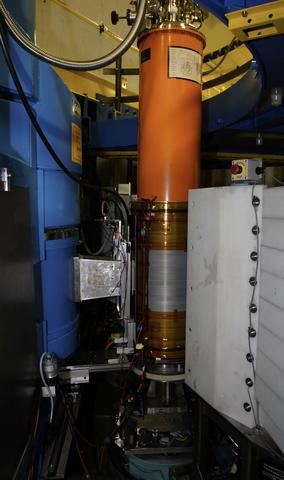MACS Wide angle polarization analysis capability

Wide-angle polarization analysis capability has been developed for MACS using 3He neutron spin filters (NSFs) located around the sample. This capability utilizes a 3He NSF to polarize the incident beam and two three-sectioned or one horseshoe-shaped wide angle 3He NSF to spin-analyze the scattered beam with an angular coverage up to a 240 degree. For MACS measurements, the neutron polarization direction is perpendicular to the scattering plane. The incident neutron polarization is flipped by inverting the 3He polarization of the polarizer. Flipping the scattered polarization is possible. Typically, non-spin flip scattering (++) and spin flipping scattering (-+) cross sections are measured
Common issues when mounting a sample for a polarized beam experiment
There are special requirements that must be considered when mounting samples for polarized beam measurements. No stainless steel of any kind should be used in or on the sample container, as that can cause uncontrolled depolarization of the neutrons. In addition, non-magnetic screws such as aluminum or brass must be used to mount the sample onto the copper block, for example, in a closed cycle refrigerator.
For operation below 1.5 K, in a dilution or 3He refrigerator, additional care should be used to avoid superconducting materials. Cd inside the sample container has caused problems (TC = 0.52 K, HC = 2.8 mT). Pure aluminum has TC = 1.2 K, HC = 10 mT; 6061 Al alloy used for sample mounts and containers has a lower or no transition temperature, depending on the detailed composition and fabrication history, and can also cause problems in some circumstances.
Polarized beam characteristics
Polarized flux: 0.3x108 n/cm2/s at 3.7 meV; 1x108 n/cm2/s at 10 meV
Initial flipping ratio: 45 at 2.5 meV; 20 at 3.7 meV; 12 at 5 meV
Initial intensity reduction factor compared to a unpolarized beam: 7.5 at 2.5 meV; 6.1 at 3.7 meV; 5.5 at 5 meV. Time-averaged intensity reduction factor is about an order of magnitude.
The sample field: 3 mT
Please note that the flipping ratios and intensity reduction factors are just an example. Other options of higher flipping ratios and lower intensity reduction factors are possible.
Cell refresh frequency
3He polarizations decay with time. 3He polarizer and analyzer(s) are refreshed every 2-4 days depending on which cell(s) are used.
Please note that optically pumping the cells takes ~2 days to maximize 3He polarizations. In addition, other instruments use the polarizers, hence the use of the polarized beam option must be requested and scheduled well in advance of an experiment.

